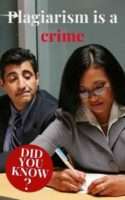The first day that I stepped into university, the lecturers kept on uttering one word: “Plagiarism”. Luckily I was well versed in the topic since my mom taught me about it when I was a teen. However, I didn’t know that plagiarism was such a big deal, so much so that it’s a crime.
What is plagiarism?
According to Scibbr, “Plagiarism means presenting someone else’s work as your own. In academic writing, plagiarizing involves using words, ideas, or information from a source without including a proper citation.”
According to P.org, “A “citation” is the way you tell your readers that certain material in your work came from another source.”
Plagiarism in essence stealing someone’s work and passing it off as your own.
Types of plagiarism
According to Scribbr there are a few forms of plagiarism:
- Copy and paste plagiarism: Just as it sounds you copy word for word from a source without citing them.
- Mosaic plagiarism: This is where you use words and phrases from different sources without citation.
- Self-plagiarism: As crazy as it sounds you can’t use work that you have previously written yourself, without citing yourself. So you can’t submit the same work for different assignments.
- Global plagiarism: This is where someone pays for someone else to write their work. For instance, you can’t ask your friend to write your assignment for you.
Example of plagiarism
So let’s say that my friend Laura has an assignment for university and she’s too lazy to do her assignment, so she quickly hops onto the internet and copies a few things from different sources.
So for her Literature explanation Laura writes, I cannot describe the depths, the length and the distance I’d go to protect you and our love.
Because Laura didn’t cite that Amber Solomons said the above quote she is in fact stealing Amber’s work.
Instead Laura should have written:
“I cannot describe the depths, the length and the distance I’d go to protect you and our love.” – (Solomons, 2021)
Citations
When we cite sources we always provide the author’s name, title of the piece, publishing company, the date and page numbers (if applicable) or even website where we got the source. Every institution has a different citation style.
When working on an assignment in university remember that there are in-text citations, which appear within the actual essay, and reference entry citations, which appears right at the end of your essay.
An in-text citation usually has the name of someone and the year: “I cannot describe the depths, the length and the distance I’d go to protect you and our love.” (Solomons, 2021)
Reference entry citation is a bit more complicated:
Solomons, A. 2021. My heart-wrenching love for you. FunDza
In most cases the above example would probably be too short, but when referencing remember to always have your institutions reference citation style guide at hand.
Who does plagiarism apply to?
Although I’ve given examples in context to university, plagiarism applies to everyone, including high school, work life and creative writing. Stealing is stealing no matter the context.
Writing for FunDza
Did you know that you have to be careful when submitting work to FunDza as well? Plagiarism doesn’t only apply to academic work but to all writing. If you submit a short story, for example, the words must be your original work or else you will be stealing from someone else. The same can be said for poems and essays. It might seem easy to copy something someone else has written on Facebook or Instagram but you cannot do this. Remember, copying someone else’s work without referencing them (giving them credit) is actually stealing and in South Africa, that is a crime.
How to check for plagiarism
A great way to check for plagiarism is to put your work into a plagiarism checker on the internet. The checker lets you know the percentage, of not necessarily plagiarism, but more so similarities between work.
This is especially helpful if you have an assignment to submit as going over a certain percentage means that you have committed plagiarism. The acceptable range for similarities is around 10%-15%, according to Scribbr. Other sources do indicate up 20%. This percentage does not mean that you can plagiarise! This simply means that checker picks up all similarities of your work in comparison to the sources. So please be aware that the checker picks up all sources including quotes, so don’t be too alarmed when you see that highlighted.
How to avoid plagiarism
- Whenever you directly use someone’s words always quote them and mention their name.
- When paraphrasing then be sure to mention the source’s name as well. Paraphrasing means that you take someone words and change it up to suit your writing style. Remember, if you don’t mention the source when you paraphrase, then it appears that you came up with the ideas, when you didn’t.
Penalties for plagiarism
According to Denise Nicholson from infojustice, the penalties for plagiarism in South Africa; “The consequences of plagiarism can be severe for academic staff or students, for example, temporary or permanent suspension or expulsion from the institution, withdrawal of a degree, funding or scholarship, 0 percent for an assignment, community service, heavy fines or other penalties.”
When you work on your next piece of writing, remember to quote and cite. Always work hard and come up with original work. There’s nothing better than the original, and that includes you.
***
Read more here on a book that doesn’t contain the letter “e”
Tell us: What did you learn from this article?


